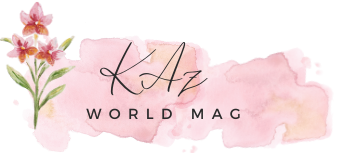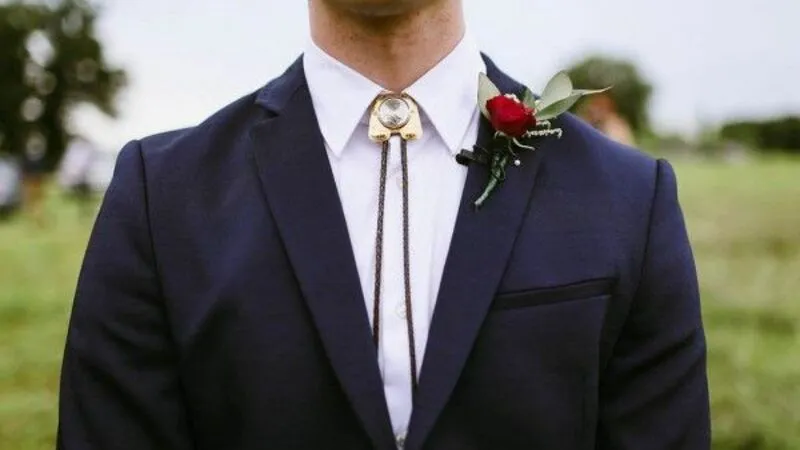The bolo tie is a unique and stylish accessory that has become an enduring symbol of Western fashion. Its distinctive design, coupled with a rich cultural history, makes it a fascinating topic for exploration. This article delves deeply into the origins, cultural impact, and various ways to wear and style the bolo tie, providing a comprehensive analysis of this iconic piece of attire. Additionally, we will include a detailed wiki bio table of its inventor, Victor Cedarstaff, to offer a complete understanding of the bolo tie’s legacy.
Historical Background
Origins and Invention
The bolo tie, also known as a bola tie or shoestring necktie, is believed to have originated in the American Southwest during the mid-20th century. While the exact origins remain a topic of debate, it is widely accepted that Victor Cedarstaff, an Arizona silversmith, invented the modern bolo tie in the late 1940s. Cedarstaff’s inspiration for creating this unique neckwear stemmed from a desire to merge practicality with style. He patented the bolo tie design, which featured a decorative clasp on a piece of cord or leather, thus formalizing its place in Western fashion.
The name “bolo” is derived from “boleadora,” a type of lasso used by Argentine cowboys, known as gauchos. This influence highlights the bolo tie’s roots in cowboy culture and its symbolic representation of the rugged yet stylish Western lifestyle.
Wiki Bio Table: Victor Cedarstaff
| Attribute | Details |
|---|---|
| Full Name | Victor Emanuel Cedarstaff |
| Birth Date | 1914 |
| Birth Place | Kansas, USA |
| Occupation | Silversmith, Inventor |
| Known For | Inventing the modern bolo tie |
| Patent Date | The late 1940s |
| Death Date | 1997 |
| Notable Achievements | Transforming Western fashion |
| Legacy | Creator of an iconic fashion accessory |
Design and Materials
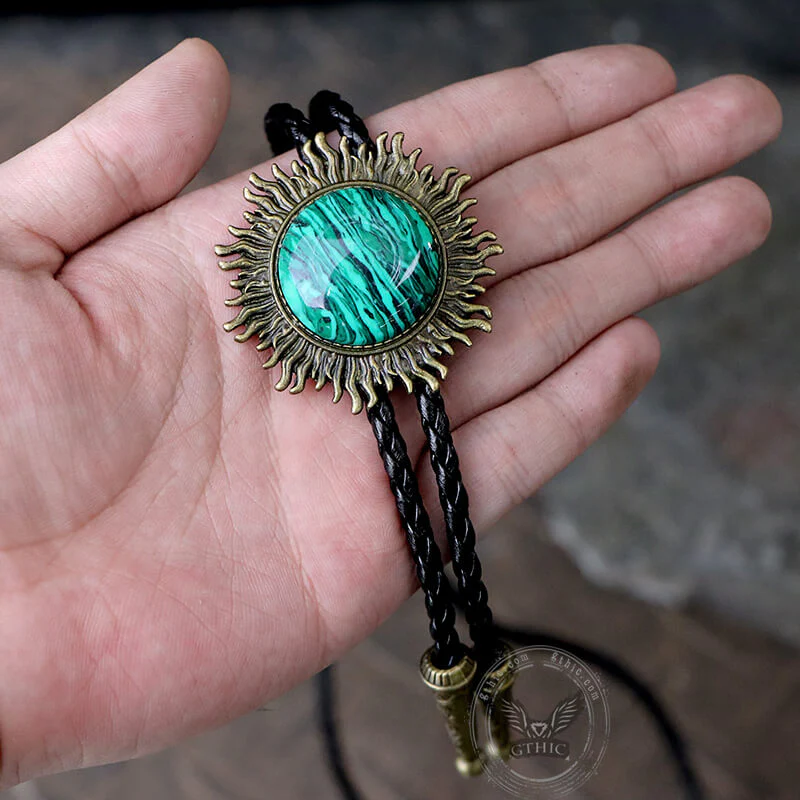
A bolo tie consists of three main components: the cord, the clasp (or slide), and the tips. Each of these elements can vary significantly in terms of materials and design, contributing to the bolo tie’s versatility and appeal.
Cord
Typically made from leather, the cord can also be crafted from braided fabric or other durable materials. The cord’s length can vary, allowing for different styles and fits. Leather cords are particularly favored for their durability and classic look, but other materials like fabric or even metal chains can be used to create a more modern or eclectic style.
Clasp/Slide
The centerpiece of the bolo tie is the clasp or slide, which is often made from metal and adorned with various decorations. Common materials include silver, turquoise, and other gemstones, creating intricate and eye-catching designs. The clasp can feature traditional Western motifs, such as eagles, cattle skulls, and Native American symbols, or modern, abstract patterns. These designs often reflect the cultural and artistic heritage of the American Southwest.
Tips
The ends of the cord are usually capped with metal tips, which not only add a decorative touch but also prevent the cord from fraying. These tips can be simple or elaborately designed, complementing the overall aesthetic of the bolo tie. Metal tips often match the material and style of the clasp, creating a cohesive look.
Cultural Significance
The bolo tie holds significant cultural importance, particularly in the American Southwest. Arizona, New Mexico, and Texas recognize the bolo tie as their official neckwear, symbolizing the region’s unique heritage and style. People often wear the bolo tie at formal events, such as weddings and rodeos, as well as in casual settings, reflecting its versatility and enduring popularity.
In addition to its regional significance, the bolo tie has been embraced by various subcultures and fashion movements. It has appeared in pop culture, worn by celebrities, and featured in movies and television shows, further cementing its status as a fashion icon. The bolo tie has also been adopted by politicians and public figures, adding to its prestige and cultural resonance.
How to Wear a Bolo Tie
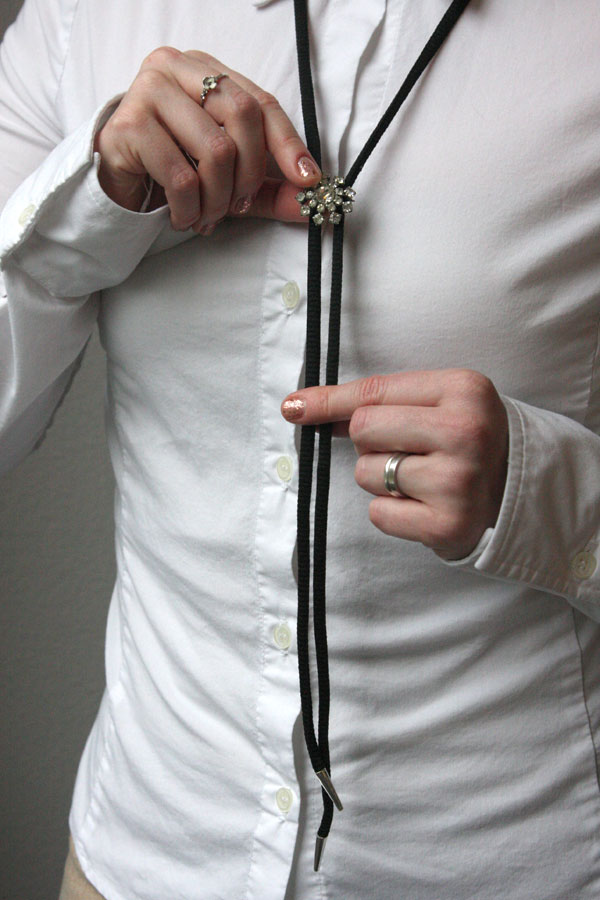
The bolo tie is a versatile accessory that can be styled in numerous ways to suit different occasions and personal preferences. Here are some tips on how to wear a bolo tie:
Formal Attire
For a formal look, pair a bolo tie with a dress shirt and a suit or blazer. Adjust the clasp to sit high on the neck, similar to a traditional necktie. This style is perfect for weddings, formal dinners, and other upscale events. A bolo tie can add a touch of individuality and Western charm to traditional formal wear.
Casual Attire
For a more relaxed look, wear a bolo tie with a button-down shirt, denim jacket, or casual blazer. The clasp can be positioned lower on the chest, creating a laid-back, yet stylish appearance. This style works well for everyday wear, social gatherings, and casual outings. The versatility of the bolo tie allows it to complement a wide range of casual outfits.
Western Wear
Embrace the bolo tie’s Western roots by pairing it with classic Western attire, such as a cowboy hat, boots, and a plaid or denim shirt. This look is ideal for rodeos, country-themed events, and other occasions celebrating Western culture. The bolo tie completes the authentic cowboy look and pays homage to its historical origins.
Creative Styling
Don’t be afraid to experiment with different looks and styles. The bolo tie can be worn with a variety of outfits, from bohemian dresses to modern streetwear, allowing for endless creative possibilities. Mixing traditional and contemporary elements can result in a unique and fashionable look.
Collecting and Caring for Bolo Ties
Collecting bolo ties can be a rewarding hobby, as there are countless designs and styles to explore. When building a collection, consider the following tips:
Research
Learn about the history and significance of different designs and materials. Understanding the cultural and artistic context of bolo ties can enhance your appreciation and knowledge as a collector. Researching the origins and stories behind specific designs can add depth to your collection.
Quality
Look for high-quality materials and craftsmanship. Authentic Native American and Western bolo ties are often made from sterling silver and genuine gemstones, which can increase their value and desirability. Paying attention to the quality of materials and craftsmanship ensures that your collection will be valuable and enduring.
Condition
Ensure that the bolo ties are in good condition, with intact cords, clasps, and tips. Proper care and maintenance can help preserve the beauty and functionality of your collection. Regular cleaning and careful storage can prevent damage and keep your bolo ties looking their best.
To care for your bolo ties, store them in a cool, dry place away from direct sunlight. Use a soft cloth to clean the cord and clasp, avoiding harsh chemicals that could damage the materials. Proper care will ensure that your bolo ties remain beautiful and functional for years to come.
Notable Bolo Tie Designers and Brands

Several designers and brands have become renowned for their exceptional bolo tie creations. These include both traditional artisans and modern designers who bring innovative approaches to this classic accessory.
Native American Artisans
Native American artisans, particularly from the Navajo, Hopi, and Zuni tribes, are famous for their intricate bolo tie designs. They often use traditional materials like turquoise and silver, creating pieces that are not only beautiful but also culturally significant. These artisans continue to preserve and innovate within the tradition of bolo tie-making.
Western Brands
Brands like Rockmount Ranch Wear, Montana Silversmiths, and Bolotie.com have gained popularity for their high-quality bolo ties that blend traditional Western aesthetics with contemporary design elements. These brands offer a wide range of designs, catering to different tastes and preferences.
Modern Designers
Modern designers are also incorporating bolo ties into contemporary fashion, creating unique pieces that appeal to a broader audience. Designers like Hedi Slimane and Ralph Lauren have featured bolo ties in their collections, bringing this classic accessory to the high-fashion runway. These modern interpretations often combine traditional elements with innovative materials and designs.
The Bolo Tie in Popular Culture
The bolo tie has made numerous appearances in popular culture, further cementing its status as an iconic accessory. From movies and television to music and fashion, the has been embraced by a diverse range of cultural influencers.
Movies and Television
The bolo tie has been featured in various films and TV shows, often symbolizing a character’s connection to Western culture or their unique sense of style. Notable examples include characters in “Breaking Bad”, “Dallas”, and “No Country for Old Men”. These appearances have helped to popularize the bolo tie and introduce it to new audiences.
Music
Musicians, particularly those in country and rock genres, have often sported bolo ties as part of their stage attire. Artists like Willie Nelson, Johnny Cash, and Neil Young have worn bolo ties, making them a recognizable symbol of the music industry. The bolo tie adds a distinctive touch to their stage presence and reinforces their connection to Western and American culture.
Fashion
Fashion icons and designers have also embraced the bolo tie, incorporating it into high-fashion looks and everyday wear. The has been seen on runways, in fashion editorials, and on celebrities at major events, demonstrating its versatility and timeless appeal. The incorporation of bolo ties into mainstream fashion highlights their enduring relevance and adaptability.
The Bolo Tie Today
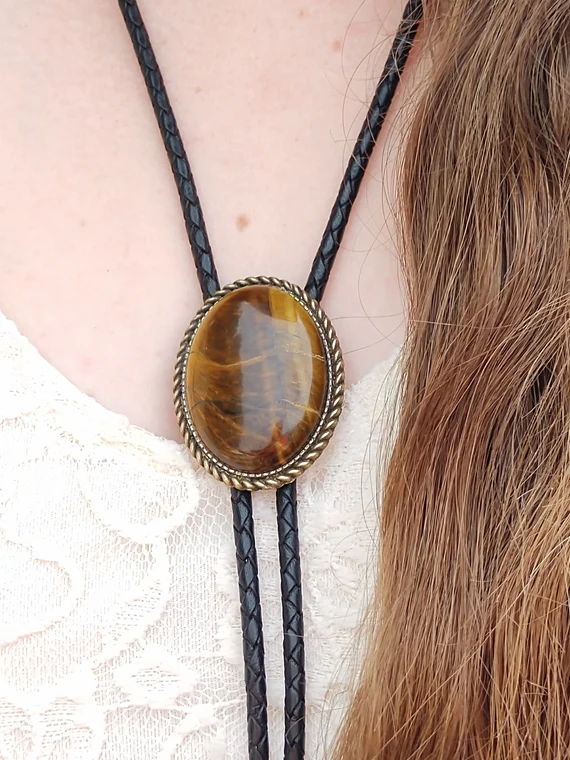
In contemporary fashion, the bolo tie continues to evolve and inspire. A new generation of fashion enthusiasts embraces and appreciates its unique blend of tradition and innovation. Its versatility allows for various styling options, making it a popular choice for both formal and casual occasions.
Modern Trends
Current trends in bolo tie fashion include mixing traditional designs with modern elements, such as incorporating unconventional materials or pairing ties with contemporary outfits. This blending of old and new creates fresh and exciting looks that appeal to a wide audience. Modern trends also emphasize personalization, with many people choosing custom bolo ties that reflect their style.
Sustainable Fashion
The bolo tie also aligns with the growing interest in sustainable fashion. Many bolo ties are handcrafted by artisans using traditional techniques, which supports sustainable practices and promotes the preservation of cultural heritage. Choosing high-quality, handcrafted bolo ties contributes to the sustainable fashion movement and supports artisans.
The Future of the Bolo Tie
The bolo tie’s future looks bright as it continues to be a beloved accessory that bridges the gap between tradition and modernity. Its enduring appeal lies in its unique design, cultural significance, and versatility. As fashion trends evolve, the bolo tie remains a timeless and adaptable accessory that can be reinvented and reinterpreted for future generations.
Conclusion
The bolo tie is more than just a fashion accessory; it is a symbol of Western heritage, creativity, and individuality. Its unique design and cultural significance have made it a beloved piece of attire for generations. Whether worn for formal occasions, casual outings, or as a statement piece, the tie continues to captivate and inspire fashion enthusiasts around the world. Embrace the timeless charm of the tie and discover the endless possibilities it offers for personal expression and style. If you have any questions, please visit the Kaz World Mag.
